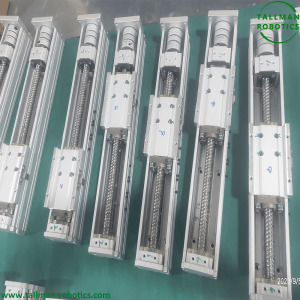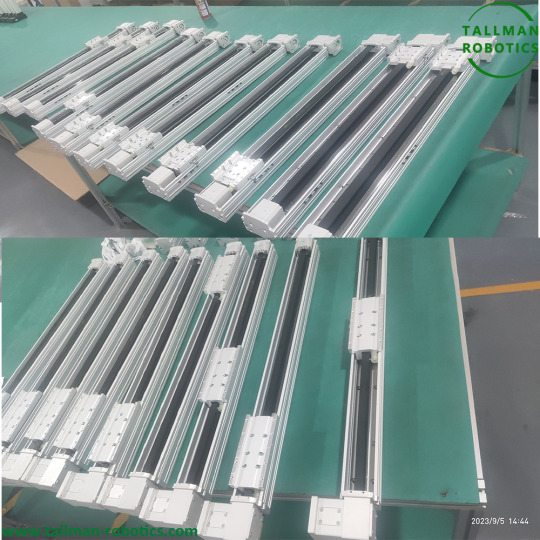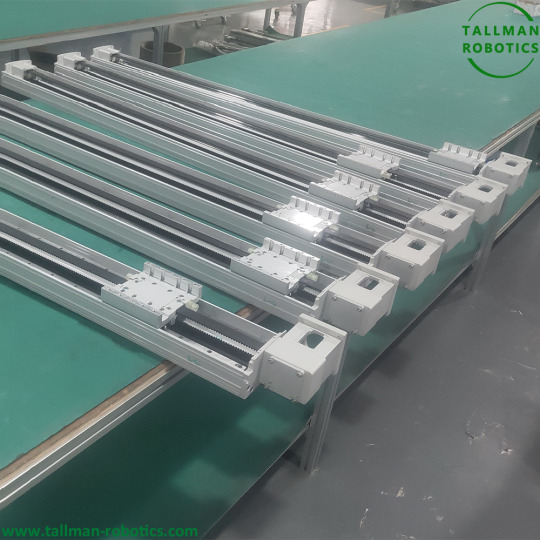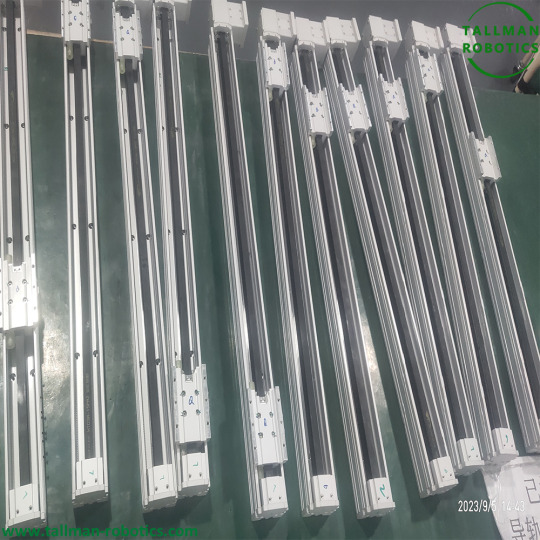#LinearSlidingGuide
Explore tagged Tumblr posts
Text
Linear Guide Way Modules are finished for Clients from India


Linear Guide Way Modules are ready for delivery to Clients from India. Linear guide way modules are mechanical components used in various applications to provide linear motion and support. They consist of a linear guide rail and a carriage or slider that moves along the rail. The guide rail typically has precision-machined surfaces, such as grooves or tracks, that allow the carriage to slide smoothly and accurately. Linear guide way modules offer several benefits, including: 1. Precise and smooth motion: The design of linear guide way modules ensures accurate and smooth linear motion, making them suitable for applications that require precise positioning and high repeatability. 2. Load-bearing capacity: Linear guide way modules can support significant loads, making them suitable for applications that involve heavy equipment or machinery. 3. Rigidity and stiffness: These modules are designed to provide high rigidity and stiffness, which helps minimize deflection and ensure stability during operation. 4. Low friction and wear: Linear guide way modules often incorporate rolling elements, such as balls or rollers, to reduce friction and wear. This design choice improves efficiency and prolongs the lifespan of the module. 5. Configuration flexibility: Linear guide way modules are available in various sizes, lengths, and configurations, allowing for flexibility in design and integration into different applications. Linear modules find applications in numerous industries, including manufacturing, automation, robotics, machine tools, semiconductor equipment, and more. They are commonly used in CNC machines, linear motion systems, industrial robots, and other precision equipment that require controlled linear motion. It's worth noting that there are different types of linear actuators available, such as ball guides, roller guides, and magnetic guides. Each type has its own advantages and is suitable for specific applications based on factors like load capacity, speed, precision requirements, and environmental conditions. Overall, linear modules play a crucial role in providing reliable and precise linear motion in a wide range of industrial and automation applications. You are welcome to https://www.youtube.com/@tallmanrobotics to watch our video centre for more projects or visit our website to check other series or load down e-catalogues for further technical data. Read the full article
#1-axislinearmodule#DustproofLinearGuide#LinearCarriagesAndSlides#LinearMotionGuide#LinearSlidingGuide#SingleAxisGuideArm#SingleAxisRobot
0 notes
Text
Linear Motion Actuators Are Under Assembly

Linear Motion Actuators are devices that convert rotational motion into linear motion. They are commonly used in various applications where linear movement is required, such as robotics, automation systems, industrial machinery, and automotive systems. Linear motion actuators provide controlled and precise linear displacement, allowing them to perform tasks like pushing, pulling, lifting, or positioning objects.



Linear Motion Electric Actuators are versatile and widely used in various applications where precise control, automation, and compactness are important. Some common applications of electric actuators include: 1. Robotics: Electric actuators play a fundamental role in robotic systems, enabling precise and controlled movement of robot arms, grippers, and joints. They provide the necessary motion control for tasks such as pick and place, assembly, welding, and inspection in industrial and collaborative robot applications. 2. Automation Systems: Electric actuators are extensively used in automation systems across industries, including packaging, material handling, and assembly lines. They provide linear motion for tasks like conveyor belt control, part positioning, sorting, and machine loading and unloading. 3. Medical Equipment: Electric actuators find applications in medical devices and equipment, such as hospital beds, patient lifts, surgical tables, and adjustable medical chairs. They allow for smooth and precise adjustment of the equipment's position, ensuring patient comfort and facilitating healthcare professionals' work. 4. Automotive Systems: Electric actuators are used in various automotive applications, including power windows, seat adjustments, trunk lifts, and electric steering systems. They provide controlled and reliable motion for convenience, comfort, and safety features in vehicles. 5. HVAC Systems: Electric actuators are employed in heating, ventilation, and air conditioning (HVAC) systems for controlling dampers, valves, and airflow. They enable precise adjustment of temperature, airflow direction, and ventilation, improving energy efficiency and comfort in buildings. 6. Aerospace and Defense: Electric actuators are used in aerospace and defense applications, such as aircraft wing flaps, landing gear, throttle control, and missile guidance systems. They offer precise and rapid motion control in critical aerospace and defense operations. 7. Home Automation: Electric actuators are utilized in home automation systems for tasks like opening and closing curtains, blinds, windows, and doors. They provide convenient and automated control over these household functions. 8. Entertainment and Motion Simulators: Electric actuators are employed in entertainment industry applications, including motion simulators, virtual reality systems, and amusement park rides. They create realistic and immersive experiences by providing motion and vibration effects. Linear Motion Actuators offer advantages like precise control, compact size, quiet operation, energy efficiency, and easy integration with control systems. They are well-suited for applications that require accurate positioning, automation, and control flexibility. You are welcome to https://www.youtube.com/@tallmanrobotics to watch our video centre for more projects or visit our website to check other series or load down e-catalogues for further technical data. Read the full article
#1AxisGantry#LinearCarriagesAndSlides#LinearSlidingGuide#MultiAxisLinearActuator#SingleAxisGuideArm#SingleAxisLinearActuator#SingleAxislinearmotion#SingleAxisStages
0 notes